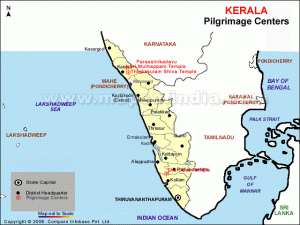Stumbling upon a treasure… isn’t that anyone’s dream?… But what happens when that dream becomes a reality! A treasure amounting to over a hundred thousand crore rupees, consisting of gold, diamonds, precious stones, idols and more that date back to the days of Napoleon and the East India company, with experts saying even more treasures are waiting to be discovered in its secret vaults, the Padmanabhaswamy Temple, one of Kerala’s most famous Lord Vishnu Temples is suddenly the centre of attention…on everyone’s search lists, with people wanting to know more about the temple, its past, etc.
Suddenly finding itself becoming the richest temple probably not just in India but perhaps the world, for those curious minds, looking up the temples here’s the Padmanabhaswamy temple for you!
Located within the Fort of Thiruvananthapuram, the Padmanabhaswamy or Sree Ananda Padmanabhaswamy Temple is an 18th century Dravidian styled temple dedicated to Lord Vishnu, the supreme power controlling the universe, according to the Hindu mythology. Even Kerala’s capital city Thiruananthapuram derived its name from this temple, the place where Lord Vishnu reclines on the sacred serpent Anantha.
A magnificent seven tier temple covered with spectacular carvings, this temple is known to have over 300 exquisitely carved pillars, a majestic platform, the Kulasekharamandapam, while murals depicting mythical stories decorate its walls.
Within the sanctum santorum of the temple, one can find an 18 feet long idol of Lord Vishnu reclining on the Holy Serpent Anantha(the hooded snake). This magnificent figure covered with gold and precious stones was built with Salagrama stones brought from Nepal.
Capturing everyone’s attention is the seven tier gopuram (monumental tower) that is 100 feet tall, and an eighty foot flag staff that stands in front of the ‘prakaram’ (corridor). A mix of Dravidian and Kerala styles of architectures, the temple as we see it today was built by one of Travancore’s most powerful leasers, Maharaja Marthanda Varma.
It was in 1750, the Maharaja devoted his kingdom to Lord Padmanabha, the presiding deity of the kingdom and assumed the title Padmanabhadasa (the servant of Lord Padmanabha). From then on the capital’s rulers have carried out all their duties – spiritual or princely as servants of the Lord.
Considered as one among the seven Parasurama shetras in Kerala, the Padmanabhaswamy temple is amongst the 108 sacred temples in India devoted to Lord Vishnu. It finds its mention in Skanda purana and the Padma purana and was even worshipped by Chandra (Moon God) and Lord Indra (the head of the Devas) by per mythology.
Attracting nearly 3-4 million devotees here every year, the Sabarimala Temple located on the Sabari Hills is one with an interesting legend to it, dedicated to Lord Ayappa. It is said Lord Ayappa(also known as Prince Manikandan) was a result of the divine union between enchantress Mohini and Lord Shiva. Lord Shiva entrusted him to Pandya King Rajasekara.While the king looked after him as his own, and declared him the crown prince at the tender age of 12, the queen however wanting her own child to be crowned tricked Prince Manikandan into leaving for a forest by claiming she suffered from an incurable headache which could only be cured if the prince returned with a tigress’ milk. En route, the prince slayed the demon Manishi, and the celestial beings to show their gratitude, turned into tigers and tigresses. On seeing the prince return with these beasts, the king & queen begged for his forgiveness. When the prince decided to leave for his heavenly abode his foster parents pleaded for him to stay, in the temple on the Sabari hills. He also agreed to appear in a form of a star that can be seen on Makar Sankranti.
Regarded as the Dwaraka of South India, the Guruvayoor Temple is known for its healing powers. It is also knowm to bless childless couples with healthy babies. While records show the temple was constructed in the 14th century, mythology claims that Guru (Preceptor of the Devas) and Vayu (The God of Winds) reclaimed a child like idol from the ravaging floods that submerged Dwarka. Lord Shiva is said to have sanctified Guruvayoor and the idol of Sri Krishna placed here and a temple was built around it.
Other important temples in Kerala include the Thiruvalla Temple at Alappuzha, A brilliant example of classic Kerala Temple architecture, it is known for its fabulous murals and exquisite rock carvings. Also dedicated to Lord Vishnu, this temple sometimes referred to as Sree Vallabha Temple is known for its 50 feet tall flag post and 3 feet tall idol of Garuda the majestic eagle mount of Lord Vishnu. Believed to be built near a natural spring, it is said the bottom end of the flag post is deep enough to touch the underground surface.
One of Kerala’s most exquisite temples, the Ettumanoor Shiva Temple located near Kottayam is known for its breathtaking murals depicting scenes from Hindu texts, such as the Ramayana, Mahabharata, Puranas, etc. Attracting art lovers not just for its beautiful murals, but also its magnificent conical gopurams, this temple is home to 14 breathtaking exquisite gopurams.
While the main Shrine is dedicated to Lord Shiva, the temple is known for some elegant sculptures and paintings of the dancing Shiva; smaller shrines are dedicated to Bhagavati, Dharma Sastha, Ganapathy and Yakshi. The Ettumanoor temple was the wealthiest Devaswom in Kerala.
Besides temples, mosques such as the Jama-at-Mosque, The Cheraman Juma Mosque, Madayi Mosque, Kanjiramattom Mosque etc, churches like Santa Cruz Basiillica, St.Francis Church & St.Mary’s Valiya Palli, even Synagogues such as the Jewish Synagogue are known to attract devotees & pilgrims.
While today Kerala’s temples are attracting tourists from all over, and the Padmanabhaswamy Temple in particularly is in the news, most pilgrim monuments of the states are known for their astounding architecture, sculpture, murals and more making each a treasure in their own way!
Certainly worth a visit to ‘God’s Own Country!’

